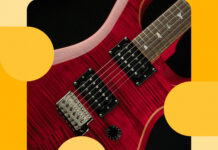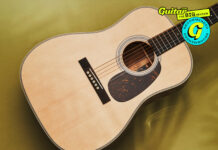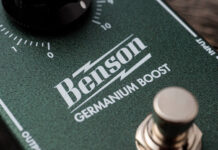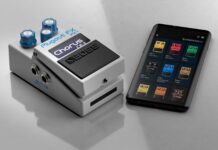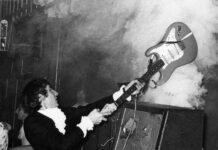
Vintage Bench Test: 1961 Jazzmaster VS 1966 Jaguar shootout
Although they share a vibrato system, rhythm circuit and offset-waist body shape, when you consider their pickups, scale lengths and controls, the Jazzmaster and Jaguar are arguably every bit as different as a Telecaster and a Strat.
Just like Leo’s dynamic duo of the early 1950s, there was a four year gap between the introduction of the Jazzmaster as Fender’s flagship model in 1958, and the Jaguar assuming the mantle in 1962. Both offsets are proof positive of Leo Fender’s growing confidence as an instrument designer and provide insights into Fender’s strategy at the end of its first decade. To find out what this means for the player, we’re putting a 1961 Jazzmaster head to head with a 1966 Jaguar.
White lines
Olympic White is an iconic Jazzmaster finish, but there’s no certainty that our example looked like this when it left the factory in 1961. The finish is convincing enough to have deceived both the previous owner and the dealer it was sold to, but the current custodians at ATB Guitars took a more careful look and found evidence of grey primer and brown wood stain in the neck cavity, confirming this as a respray.
It was clearly refinished by a professional and it was done so long ago it has the genuine appearance of age without any of the usual signifiers of a modern relic job. ATB’s theory is that it was done in an automotive body shop – potentially as long ago as the 1970s. It certainly looks like the correct white acrylic oversprayed with nitrocellulose.
The nitro has yellowed over the years, giving it an authentic early 1960s look, and while the yellowed areas fluoresce under black light, the white areas don’t. The original tortoiseshell guard has a crack near the jack socket, shows signs of shrinkage and there is some warping, but none of those things detract from either the appearance or value.
This is one of those vintage guitars that has clearly been well played, but has absolutely no negative playability issues. Most of the finish has worn off the back of the neck, leaving that deliciously smooth vintage feel that’s so hard to replicate. The nitro on the front of the headstock appears rather thick and a little uneven, leading us to suspect the original decal was oversprayed.
The Jazzmaster’s dark Brazilian rosewood fretboard is in superb condition, with no gouges or divots, and the frets have years of life left. When this guitar was refretted, somebody was perhaps a little over-zealous when cleaning out the slots, and most of the slot ends have been oversawn into the maple. It’s common to see this on veneer ’boards, especially when the fingerboard has been sanded, but far rarer when it’s a slab ’board like this one.
The original single-line Kluson tuners feel smooth and accurate, and the hardware is all in very serviceable condition. It looks correct under the hood too, with the original wiring and shielding all intact and only a handful of solder joints disturbed.
Golden strummer
Several changes were made to the Jaguar over its first four years of production, and this 1966 example has pearl rather than clay fingerboard dots, plus neck binding and an F-branded neck plate. Jaguars were among the first Fenders to be equipped with F-stamped tuners, while block inlays would replace the dots found here by the end of the year. Although few would argue that the Schaller-made tuners were an improvement on the Klusons Fender used from the very beginning, this guitar’s F-stamps are smooth and stable.
For a guitar of its age, this Jaguar is in impressive condition and doesn’t appear to have led a particularly hard life. It’s not mint – as a sizeable dent near the rhythm circuit controls and three deep cuts in the fingerboard binding will attest – but otherwise there are just minor dents and dings. There’s no playwear on the neck and the original frets are still present. As you might expect, the CBS-era pickguard is still bright white.
The feature that sets this guitar apart, and elevates its price significantly, is the Firemist Gold finish with headstock to match. Fender introduced this classy hue in 1965 – it was a Lucite acrylic made by Dupont for Cadillac. The front of the headstock is a bit yellower than the body, and it’s possible that Fender sprayed a few more top coats of nitrocellulose to ensure that the decals would adhere properly. But both headstock and body look identical under black light.
None of the solder joints or wiring appear to have been touched, and all the hardware seems to be original. The bridge mute is present, but the foam rubber has dried out and shrunk so much, it has no effect whatsoever. Even for Jaguar fanatics, this probably won’t be a deal breaker, but functioning mutes can produce some very cool sounds, especially into spring reverb.
In use
For such superficially similar guitars, it’s quite remarkable how different these instruments feel to play. Clearly the difference in scale length is a big part of it, but there’s something about the positioning and spacing of the components that makes everything line up a little differently.
In a sitting position, the picking hand naturally ends up falling right between the Jaguar’s pickups, but it’s closer to the bridge pickup when playing the Jazzmaster. For Strat and Tele players, the Jaguar may actually feel more familiar, despite its shorter neck. With the Jazzmaster, initially at least, it’s easy to end up at the seventh fret when aiming for the fifth. It doesn’t take long to adjust, but there’s no comparable familiarisation period required with the Jaguar.
Fender Jaguar & Jazzmaster Pickups
1 of 4
1966 Fender Jaguar neck pickup
1966 Fender Jaguar bridge pickup
1961 Fender Jazzmaster bridge pickup
1961 Fender Jazzmaster bridge
There’s also a very different feel to the neck profiles. The Jazzmaster has a near textbook example of an early-60s Fender neck. It’s rounded and quite slim at the headstock end, yet still somehow conforms to your palm like a sublime 50s Gibson. It stays fairly slim up to the seventh fret, where it begins its rapid transition across the next three frets into a fully rounded profile.
The Jaguar’s neck is almost entirely different to the Jazzmaster’s in every regard. It’s all about consistency, because the depth remains almost identical from headstock to heel and the feel is more of a D than a rounded C. It also feels both thicker and thinner than the Jazzmaster neck in the low and high positions respectively.
1966 Fender Jaguar fretboardThe frets make a difference, too, because the Jazzmaster has been refretted with taller and wider wire. A decent job was made of it, with no damage to the playing surface, though you can feel the ’board edges have a little more rollover as the result of the bevelling.
In contrast, the Jaguar’s factory fitted frets are very low and flat, and about 0.2mm narrower. The binding nibs still survive – just about – and somebody skilled has made a valiant attempt to file a crown into the frets and bring them to a high polish.
Although they look slightly different, the controls of both guitars are more or less the same. Individual pickup switches on the Jaguar replace the Jazzmaster’s more conventional three-way toggle pickup selector, while both guitars have a rhythm circuit with low profile volume and tone controls and the small activation switch. The main point of difference is the Jaguar’s ‘strangle’ switch on the bridge side of the small chrome plate.
Fender Jaguar & Jazzmaster Fretboard
1 of 2
1966 Fender Jaguar fretboard
1961 Fender Jazzmaster fretboard
The Jazzmaster’s unplugged tone is very much in line with our expectations of an early-60s pre-CBS Fender. It’s warm, balanced, has decent sustain and plenty of bass depth. In contrast, the Jaguar is naturally brighter and chimier, with a quicker and more percussive attack but more rapid decay and less bass.
Through our Rift Princeton-style amp, the Jazzmaster delivers a wide range of warm, bold and twangy tones. It’s a big sound without being overblown, and there’s something about the attack and decay characteristics that’s reminiscent of the wooden bridges on archtops.
Following on from the Telecaster and Strat, the Jazzmaster was essentially the next rung on Fender’s evolutionary ladder, so it’s interesting to compare its pickups with those of its predecessors. Fender seems to have been shooting for fidelity and balance, and the neck/bridge tonal contrast is significantly less pronounced than on Teles and Strats.
The Jazzmaster bridge isn’t naturally disposed towards wiry bite and quack, and the neck probably got closer than ever before to the jazz tones Leo Fender designed the model to provide. In real-world playing situations this means you are less likely to get the urge to mess with your amp settings every time you switch pickups.
Fender Jaguar & Jazzmaster headstocks
1 of 2
1961 Fender Jazzmaster headstock
1966 Fender Jaguar headstock
Continuing this evolutionary theme, the Jaguar seems like an attempt to retain that balance between the neck and bridge, but shoot for even greater fidelity, as there’s a clarity here that is perhaps a cut above the guitars that came before. That’s not to say that the treble is excessive or shrill, but simply that the tone is wide open, airy and precise. The bridge pickup is also nice and full in the midrange, which isn’t something that can be said for too many Stratocasters.
But since vintage Strat and Jaguar pickups appear so similar – especially Jaguar pickups such as these, with staggered slugs – what accounts for the tonal differences? It’s a much-debated topic, but it has been suggested that the metal claws on Jaguar pickups were Leo’s attempt to balance the response by altering the magnetic field to bolster the plain strings.
Look closely and you’ll see that the ‘teeth’ are not all equal in height. The taller teeth were intended to correspond with the plain strings, so it would appear that both the claws on this Jaguar may be the wrong way around.
1966 Fender Jaguar tunerSome argue that the claws have little or no audible effect, but if that’s the case then we wonder why there’s plenty of body to the sound and the treble isn’t excessive when the Jaguar, like the Jazzmaster, is equipped with one-meg control pots. Anybody who has played a Strat or Tele with one-meg pots will know that the treble can be challenging, so something different is clearly going on.
Fans of the much-maligned rhythm circuit will be relieved to hear it’s getting a proper evaluation here. We can’t quite replicate the rhythm circuit tone simply by selecting the neck pickup and dialling the tone control back – there’s something fuller and bouncier in the lows and low mids that makes the rhythm circuit better suited to comping jazz chords.
1966 Fender Jaguar switchesGranted that’s a little niche, but try activating a fuzz pedal and the rhythm circuit actually sounds fatter, smoother and clearer. Start exploring delay and extreme reverb effects, and you’ll be in ambient heaven.
Under the influence of a Big Muff, the Jazzmaster soars into J Mascis and 90s indie-rock territory, but the Jaguar sounds a couple of decades older, channelling mid-60s garage rock as readily as Morricone soundtrack stylings – especially with the mid/bass cut of the strangle switch engaged.
1961 Fender Jazzmaster Controls
1 of 4
1961 Fender Jazzmaster knob
1961 Fender Jazzmaster knob
1961 Fender Jazzmaster switch
1961 Fender Jazzmaster rotary switch
The Jaguar’s shorter sustain, woody punch and chiming clarity through a clean Fender or Vox amp is pretty unbeatable for 60s-inspired rhythm parts. And if 1980s indie arpeggios are what you want, the results are instantaneous and guaranteed.
Noise pioneers such as Sonic Youth began playing offsets because they were cheap but high quality options in the shred-obsessed 1980s guitar market. Although vintage offsets are nowhere near as affordable as they once were, they’re still priced lower than Strats and Teles from the same era.
1966 Fender Jaguar bridge plateOur Firemist Gold Jaguar commands a premium because of its originality, condition and rare custom colour finish. You could buy a regular sunburst ’66 model for less than half of the current asking price, but this is indisputably a collector grade example. That said, we hope it ends up with a collector who appreciates just how fine a musical instrument it is.
With a price that’s not much higher than modern Fender Custom Shop version, the Jazzmaster’s refin not only makes it a relative bargain, but also a blank canvas should you prefer to have it finished again in a different colour. Either way, there’s a lot of fun to be had on the path to sonic exploration.
Key Features
1961 Fender Jazzmaster
PRICE £4,495
DESCRIPTION Solidbody electric guitar, made in the USA
BUILD Solid alder body, bolt-on maple neck with Brazilian rosewood slab fingerboard, clay dot markers
HARDWARE Offset vibrato bridge, Kluson single line tuners
ELECTRONICS 2x single-coil pickups, master volume and tone, 3-way pickup selector switch, independent rhythm circuit with volume and tone
SCALE LENGTH 648mm/25.5″
NECK WIDTH 41.7mm at nut, 51.2mm at 12th fret
NECK DEPTH 19.9mm at first fret, 24.3mm at 12th fret
STRING SPACING 33.6mm at nut, 56.5mm at bridge
WEIGHT 3.79kg/8.35lb
FINISH Olympic White (refinish)
1966 Fender Jaguar
PRICE £7,995
DESCRIPTION Solidbody electric guitar, made in the USA
BUILD Solid alder body, bolt-on maple neck with bound rosewood veneer fingerboard, pearl dot markers
HARDWARE Offset vibrato bridge, F-stamped tuners
ELECTRONICS 2x single-coil pickups, master volume and tone, individual pickup selector switches, mid/bass cut ‘strangle’ switch, independent switchable rhythm circuit with volume and tone
SCALE LENGTH 609 mm/24″
NECK WIDTH 41.7mm at nut, 51.4mm at 12th fret
NECK DEPTH 22.6mm at first fret, 22.2mm at 12th fret
STRING SPACING 35mm at nut, 54.9mm at bridge
WEIGHT 3.7kg/8.1lb
FINISH Firemist Gold
CONTACT atbguitars.com
The post Vintage Bench Test: 1961 Jazzmaster VS 1966 Jaguar shootout appeared first on Guitar.com | All Things Guitar.
Source: www.guitar-bass.net


